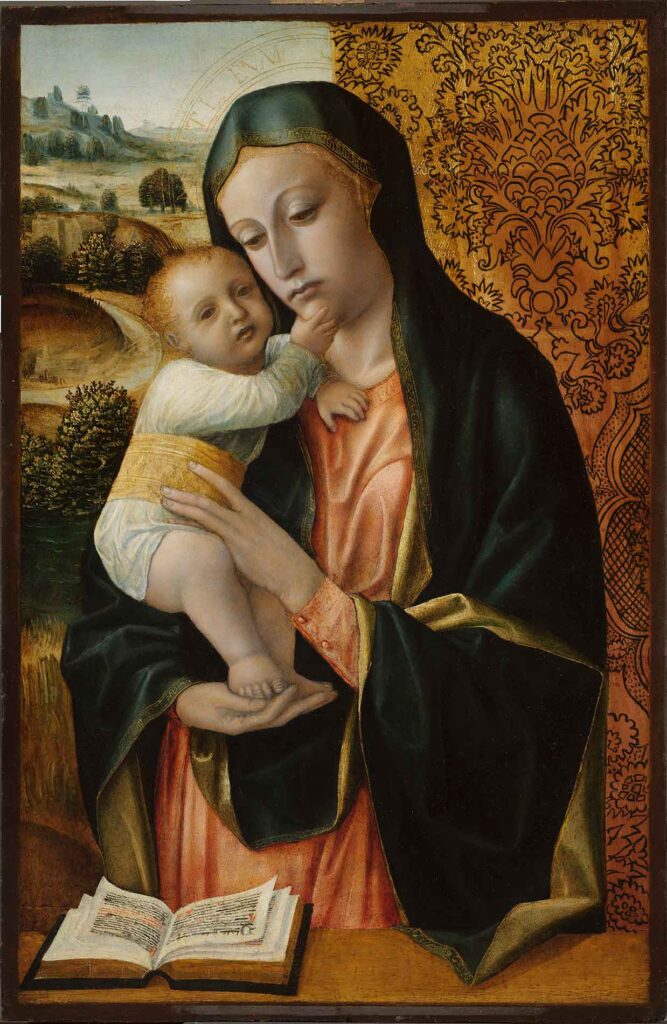Madonna and child
Vincenzo Foppa , ca. 1495 - 1500
Description

This beautiful work, datable to the late 15th century is magnificent mature work by the great Lombard Master Vincenzo Foppa.
The tenderness between the Mother and her Son is expressed with the delicate gesture of Jesus stroking Mary’s face. Their eyes do not meet, and the sadness of their faces is perhaps a premonition of Christ’s future sacrifice.
The traditional gold background is replaced with a precious velvet textile decorated with a large thistle flower, which also alludes to the Passion of Christ. This solution shows the innovative character of the artists among the earliest protagonists of the Renaissance in Lombardy.
In the painting, on the left, a beautiful landscape with a river is painted with quick brush strokes.
On the Virgin’s halo a Latin inscription reads: GENUISTI EUM QUI TE FECIT, you gave birth to the one who created you.
In the sober and essential colour palette dominate the red of the Virgin’s garment and the dark blue of her cloak. The planes of depth of the composition are rendered simply and effectively: from the foreground close to the viewer, with the parapet on which rests an open prayer book, to the figures of the Virgin and Child – occupying a three-dimensional space, almost to simulate the effect of a sculpture in the round – to the background with the line of the horizon of the landscape.
Data Sheet
Author
Vincenzo Foppa, Brescia, documented 1450-1515/1516
Date
ca. 1495 - 1500
Material and technique
Tempera on panel
Measures
61 cm x 38 cm
Acquisition
Gian Giacomo Poldi Pezzoli bequest, 1879
Inventory number
1643
location
Lombard Rooms
The three rooms display Lombard paintings of the Renaissance, made during the years (1450-1535) when Milan and Lombardy were ruled by the Sforzas, who gave birth to one of the most splendid courts in Europe. They are mostly panels for private devotion, purchased by Gian Giacomo Poldi Pezzoli in the later 19th century.
Beginning in 1450, Vincenzo Foppa helped give a new identity to Lombard art, and this renewal was joined in the last quarter of the 15th century by the presence in Milan of the Urbino architect Donato Bramante and the Florentine Leonardo da Vinci
Thanks to Leonardo, an artistic school developed that drew from his teachings the skilful use of sfumato, the careful study of nature, and the rendering of movement and the motions of the figures’ souls.
The rooms feature works by both his pupils such as Giovanni Antonio Boltraffio, Marco d’Oggiono, and artists who compared themselves with him such as Bernardo Zenale, Giampietrino, Cesare da Sesto, Andrea Solario, and Bernardino Luini.
Since 1951 the tablets that decorated Palazzo Vimercati in Crema (c. 1500) have been displayed on the ceiling. They were a typical decoration on the ceilings of public and private buildings in Lombardy between the Gothic and Renaissance periods.
The new lighting was provided by the Associazione Amici del Museo Poldi Pezzoli.
collection
Paintings
The Museum hosts over 300 paintings. Among them, many Italian works from the Renaissance: masterpieces from Tuscany (Botticelli, Piero della Francesca, Pollaiuolo), Lombardy (Luini, Boltraffio, Solario) and Veneto (Bellini, Mantegna). Important is also the group of 18th century Italian painting (Guardi, Canaletto, Tiepolo, Fra Galgario). In the collection, there are mainly portraits and small size paintings.
